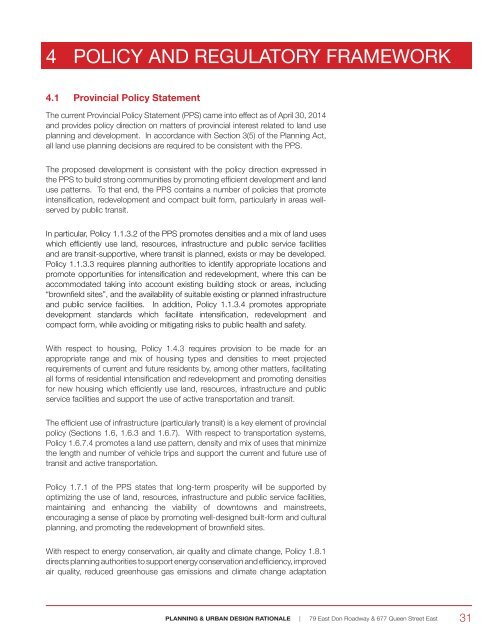Create successful ePaper yourself
Turn your PDF publications into a flip-book with our unique Google optimized e-Paper software.
4 POLICY AND REGULATORY FRAMEWORK<br />
4.1 Provincial Policy Statement<br />
The current Provincial Policy Statement (PPS) came into effect as of April 30, 2014<br />
and provides policy direction on matters of provincial interest related to land use<br />
planning and development. In accordance with Section 3(5) of the Planning Act,<br />
all land use planning decisions are required to be consistent with the PPS.<br />
The proposed development is consistent with the policy direction expressed in<br />
the PPS to build strong communities by promoting efficient development and land<br />
use patterns. To that end, the PPS contains a number of policies that promote<br />
intensification, redevelopment and compact built form, particularly in areas wellserved<br />
by public transit.<br />
In particular, Policy 1.1.3.2 of the PPS promotes densities and a mix of land uses<br />
which efficiently use land, resources, infrastructure and public service facilities<br />
and are transit-supportive, where transit is planned, exists or may be developed.<br />
Policy 1.1.3.3 requires planning authorities to identify appropriate locations and<br />
promote opportunities for intensification and redevelopment, where this can be<br />
accommodated taking into account existing building stock or areas, including<br />
“brownfield sites”, and the availability of suitable existing or planned infrastructure<br />
and public service facilities. In addition, Policy 1.1.3.4 promotes appropriate<br />
development standards which facilitate intensification, redevelopment and<br />
compact form, while avoiding or mitigating risks to public health and safety.<br />
With respect to housing, Policy 1.4.3 requires provision to be made for an<br />
appropriate range and mix of housing types and densities to meet projected<br />
requirements of current and future residents by, among other matters, facilitating<br />
all forms of residential intensification and redevelopment and promoting densities<br />
for new housing which efficiently use land, resources, infrastructure and public<br />
service facilities and support the use of active transportation and transit.<br />
The efficient use of infrastructure (particularly transit) is a key element of provincial<br />
policy (Sections 1.6, 1.6.3 and 1.6.7). With respect to transportation systems,<br />
Policy 1.6.7.4 promotes a land use pattern, density and mix of uses that minimize<br />
the length and number of vehicle trips and support the current and future use of<br />
transit and active transportation.<br />
Policy 1.7.1 of the PPS states that long-term prosperity will be supported by<br />
optimizing the use of land, resources, infrastructure and public service facilities,<br />
maintaining and enhancing the viability of downtowns and mainstreets,<br />
encouraging a sense of place by promoting well-designed built-form and cultural<br />
planning, and promoting the redevelopment of brownfield sites.<br />
With respect to energy conservation, air quality and climate change, Policy 1.8.1<br />
directs planning authorities to support energy conservation and efficiency, improved<br />
air quality, reduced greenhouse gas emissions and climate change adaptation<br />
<strong>PLANNING</strong> & <strong>URBAN</strong> <strong>DESIGN</strong> <strong>RATIONALE</strong> | 79 East Don Roadway & 677 Queen Street East 31



